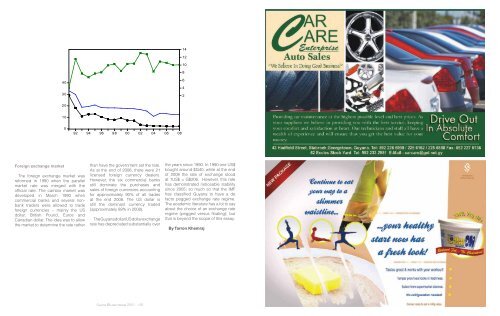Download PDF - The Georgetown Chamber of Commerce & Industry
Download PDF - The Georgetown Chamber of Commerce & Industry
Download PDF - The Georgetown Chamber of Commerce & Industry
You also want an ePaper? Increase the reach of your titles
YUMPU automatically turns print PDFs into web optimized ePapers that Google loves.
Foreign exchange market<br />
40<br />
30<br />
20<br />
10<br />
<strong>The</strong> foreign exchange market was<br />
reformed in 1990 when the parallel<br />
market rate was merged with the<br />
<strong>of</strong>ficial rate. <strong>The</strong> cambio market was<br />
developed in March 1990 when<br />
commercial banks and several nonbank<br />
traders were allowed to trade<br />
foreign currencies – mainly the US<br />
dollar, British Pound, Euros and<br />
Canadian dollar. <strong>The</strong> idea was to allow<br />
the market to determine the rate rather<br />
0<br />
92 94 96 98 00 02 04 06 08<br />
Average lending rate<br />
Average deposit rate<br />
SPREAD (right-axis)<br />
than have the government set the rate.<br />
As at the end <strong>of</strong> 2008, there were 21<br />
licensed foreign currency dealers.<br />
However, the six commercial banks<br />
still dominate the purchases and<br />
sales <strong>of</strong> foreign currencies accounting<br />
for approximately 90% <strong>of</strong> all trades<br />
at the end 2008. <strong>The</strong> US dollar is<br />
still the dominant currency traded<br />
(approximately 89% in 2008).<br />
<strong>The</strong> Guyana dollar/US dollar exchange<br />
rate has depreciated substantially over<br />
Guyana Business 2010 | 66<br />
14<br />
12<br />
10<br />
8<br />
6<br />
4<br />
2<br />
the years since 1990. In 1990 one US$<br />
bought around $G40, while at the end<br />
<strong>of</strong> 2008 the rate <strong>of</strong> exchange stood<br />
at 1US$ = G$206. However, this rate<br />
has demonstrated noticeable stability<br />
since 2005; so much so that the IMF<br />
has classified Guyana to have a de<br />
facto pegged exchange rate regime.<br />
<strong>The</strong> academic literature has a lot to say<br />
about the choice <strong>of</strong> an exchange rate<br />
regime (pegged versus floating); but<br />
that is beyond the scope <strong>of</strong> this essay.<br />
By Tarron Khemraj


